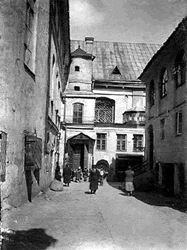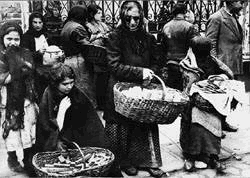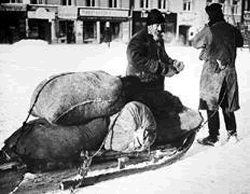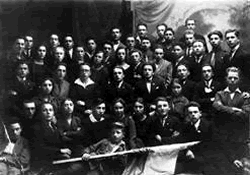http://www.bh.org.il/Communities/Archive/Vilna.asp
The Solly Yellin Center of Lithuanian Jewry
Vilna, In Lithuanian Vilnius, in Polish Wilno, in Russian Vilna, in Yiddish Vilne, capital city of Lithuania. From 1323 capital of the Grand Duchy of Lithuania, between the two World Wars, a district town in Poland, then capital of the Lithuanian S.S.R. from 1940 until 1991. Called by East European Jewry, especially in the modern period, the "Jerusalem of Lithuania" (Yerushalayim de-Lita).
Early History
The first information of an organized Jewish community in Vilna dates from 1568, when it was ordered to pay the poll tax. In February 1633 the Jews of Vilna were granted a charter of privileges permitting them to engage in all branches of commerce, distilling, and any crafts not subject to the guild organizations, but restricting their place of residence in the city. During the first half of the 17th century the Vilna community was augmented by arrivals from Prague, Frankfort, and Polish towns, who included wealthy emigrants and scholars. In this period about 3,000 Jewish residents are recorded out of a total population of some 15,000. Although the Vilna community, now an important Jewish entity, claimed the status of a principal community, or "Community Head of the Courts" (Kehillah Rosh Beth Din), within the organizational framework of the Council of Lithuania (Vaad Lita), the status was not conceded until 1652. During the uprising against Russia in 1794 a number of Vilna Jews demonstrated their loyalty to Poland in the fighting and the Kahal made contributions to the participants in the uprising. After the conquest of the city by the Russians, however, the Jewish position in commerce and crafts improved.
A Center of Torah Learning
Vilna had already become a preeminent center for rabbinical studies by the beginning of the 17th century. Among the scholars born in Vilna were Joshua Hoeschel Ben Joseph and Shabbetai Ha-Kohen, who served as dayyan of the community. The Rabbi of Vilna in the middle of the 17th century was Moses B. Isaac Judah Lima. Among the scholars of Vilna in the second half of the 17th century and the beginning of the 18th were R. Moses, called Kremer, his son-in-law Joseph, author of Rosh Yosef, Halakhic and Aggadic novellas; R. Baruch Kahana, known as Baruch Charif; the grammarian Azriel and his two sons Nisan and Elijah, and Zvi Hirsch Kaidanover. From the second half of the 18th century the personality and activities of Eliyahu ben Solomon Zalman, the Gaon of Vilna, who attracted numerous disciples, had a lasting impact on Vilna Jewry. The circle thus formed became the most stimulating religious and spiritual center there and had a profound influence on Judaism, especially in the domains of the Halakhah and Kabbalah.

The Great Synagogue Yard, Vilna, 1920-1930
Beth Hatefutsoth Visual Documentation Center
Courtesy of Leibl Korinsky, IsraelÂ
Opposition to Chassidism
At the end of the 18th century, under the influence of the Gaon, Vilna became the center of the way of life and system of religious study followed by the Mitnaggedim and the focus of their struggle against Hasidism. In 1772 the Kahal disbanded the congregation formed in Vilna by the Hasidim and issued a ban or excommunication against them.Bitter opposition to Hasidism continued throughout the lifetime of the Gaon. Nevertheless, groups of Hasidim still assembled clandestinely in Vilna and formed their own minyanim, and after 1790 the movement even found support among members of the Kahal. In 1798 the Vilna Kahal was prohibited from imposing fines or corporal punishment for religious offenses. When the Hasidic leader Shneor Zalman of Lyady was denounced to the authorities and imprisoned, 22 Hasidim from Vilna and its environs were also incarcerated, although afterward released. The Kahal elders and dayyanim were dismissed from office in 1799, and the Kahal accounts were examined. A new Kahal was then chosen from among the Hasidim, which controlled the Vilna community for over a year. Subsequently the two parties became reconciled and a new Kahal was elected with representatives of both parties. The Hasidim were permitted to form their own congregations.

Jewish vendors in Vilna.
Photo taken by the German Army during WW1
Beth Hatefutsoth Visual Documentation Center
Gringras CollectionÂ
The 19th Century
Vilna's preeminence as the seat of Jewish learning continued in the 19th century. As an important center of Haskalah, it attracted many Hebrew writers. When the government commenced its policy of Russification of the Jews, it made Vilna a center of its activities. Max Lilienthal was sent there in 1842 to encourage the establishment of modern schools and in 1847 a government sponsored Rabbinical seminary was established.The restriction limiting Jewish residence to certain streets in Vilna was abrogated under Alexander I in 1861. It was in this period that the first Jewish socialists in Russia began to be active in the official Rabbinical seminary, among them Aaron Samuel Liebermann and his associates. Anti-Jewish riots took place in 1881 when a band of military conscripts attacked Jewish shops. The Jewish butchers, who organized themselves to oppose the attackers, turned them over to the police. The 1897 census shows 63,831 Jewish inhabitants, 41.9% of the total population. The congested conditions and increasing unemployment led to large-scale emigration. Large numbers left for the United States and South Africa, and a few went to Palestine.

Jewish porter pulling a sled in the streets of Vilna.
Photo taken by the German Army during WW1
Beth Hatefutsoth Visual Documentation Center
Gringras CollectionÂ
A Center of Jewish Political Activity
Vilna became an active meeting ground for Jewish socialists in the 1890s. A convention of Jewish social democrats was held in 1895, while in 1897 the Bund Labor Party held its founding convention and Vilna became the center of its activities. At the beginning of the 20th century Vilna became the center of the Zionist movement in Russia, and saw the rise of a flourishing Hebrew and Yiddish literature. One of the first societies of the Hibbat Zion movement was founded there; Chovevei Zion conventions were held in Vilna. Theodor Herzl, who visited Vilna in 1903, was given an enthusiastic popular reception. The central bureau of the Zionist organization in Russia functioned in Vilna between 1905 and 1911 and for some time the Po’alei Zion Party made Vilna its headquarters. The well-known Zionist leader Shmaryahu Levin was elected as deputy for Vilna to the Duma (Russian Parliament). Orthodox circles were organized under the leadership of R. Chayyim Ozer Grodzenski, and afterward were amalgamated with the Agudat Israel.

Members of HaShomer HaZair Zionist Youth Movement in Vilna, 1931
Beth Hatefutsoth Visual Documentation Center
Courtesy of Annie Honikman-Peretz, Israel
For the rest go to;